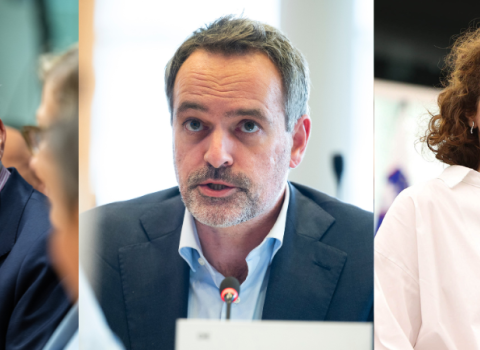
Image courtesy SKA.
The telescope, to be called the Square Kilometre Array (SKA), will be at least 40 times more powerful than any other radio interferometer – so powerful that it could eavesdrop on a cell-phone conversation (if any) on another planet. Its scientific purposes include probing into the dark ages of the universe – the residual radio emissions from the formation of the first stars, black holes, galaxies and ‘dark’ matter and energy.
The SKA Dossier
Presentations on the Square Kilometre Array telescope, from the COST Office conference on the subject in Rome, can be downloaded here: http://www.cost.eu/events/ska
“The benefits are long-term spill-over,” into the economy, technology development, education and other fields, says Patricia Kelly, deputy director of the Australian Department of Innovation, Industry, Science and Research. Her government has committed A$200 million to preparatory projects, and enlisted New Zealand as a partner. It has set aside a desert preserve in Western Australia a third the size of the Netherlands to site the core telescope components. And it has a strong track record in exploiting radio astronomy: in the 1990s a group of Australian researchers, struggling for a better way to manage the reams of data created by their telescopes, filed key patents for what is now the WiFi wireless-Internet standard 802.11 used by hundreds of millions of people around the world. Enforcing those patents has netted the state scientific-research agency, CSIRO, $200 million in US legal settlements, Kelly says.
South Africa, meanwhile, is making all-out diplomatic and commercial efforts to win the project – arguing it would be the first international, ‘big science’ tool ever built in sub-Saharan Africa, and is thus a powerful driver for the region’s scientific and educational base. Indeed, while the economic benefits are important and many jobs will be created, Bernie Fanaroff, project director for the country’s SKA effort says, “the primary benefits for Africa are not tangible: they are the inspiration they will provide the region”.
The country has organised a coalition of seven other African nations to participate, won an official endorsement from the Organisation of African Unity, pledged 2.1 billion rand to its own preparatory projects through 2013, and stepped up its university training to raise the number of professional radio astronomers in the country to nearly 100 today, from just six in 2005, he says.
The project is also starting to attract serious interest from the world’s technology multinationals, hoping for a role in the project. A Rome conference on the telescope from March 29 - 31 was attended by representatives from IBM, Microsoft, Solvay, Thales, Finmeccanica and others. The conference, organised by COST, a European organisation for collaboration in science and technology, was entitled “Benefits of Research Infrastructures beyond Science”, and focused on identifying the economic and social ramifications of SKA. For industry, that means jobs.
For the ICT industry, the project is going to require such a leap in data processing technology that it will be a global marquee project for the contractors’ prowess – and at least 30 per cent of the €1.5 billion price tag will go towards ICT.
The SKA project highlights the growing importance of iconic ‘big science’ projects in the global research world, and the economic weight they can carry. One of the first such projects, the CERN high-energy physics lab near Geneva, is now a landmark example – a major scientific success, contributing millions to the local economy and, most famously, spawning the World Wide Web - invented by a CERN researcher trying to find a better way to index and cross-reference the lab’s millions of documents.
Generally, research infrastructure projects like SKA are important because they are “motors for change,” argues Carlo Rizzuto, president of the Trieste Synchrotron. Scientific merits aside, they have broader impact on the economy and the research community. “They attract the best researchers in the world” to Europe and thereby help raise the quality of European research.
Rizzuto cites the example of his own synchrotron in north eastern Italy, which since its founding about 20 years ago has helped spark a rise in scientific citations and peer-assessed research in its field for Italy. At the same time, he says, it has also had direct economic benefits, injecting €20 million a year into the local economy, and fostering ten spin-out companies in Italy and four across the border in Slovenia. Rizzuto is also chair of the European Strategy Forum on Research Infrastructure, an EU advisory group that maintains a pan-EU roadmap for 44 projects in development or planning (including the SKA telescope, which would involve EU members). If all 44 are built, he says, the total price tag would be about €20 billion over 10 to 15 years – but it’s often a difficult political effort to obtain such sums.
“The reaction of local political leaders and administrators is that they think it’s a waste throwing money into these holes,” Rizzuto says. So supporters have to go beyond the scientific argument and highlight the related economic and societal benefits.
For instance, he says, the construction phase of a large research infrastructure projects brings obvious local economic benefits. Even if many of the engineers and much of the technology is imported to the site, there’s still a lot of work to go around locally. But once operating, he says, a well-planned and integrated project can contribute 50 per cent to 75 per cent of its operating budget to the local economy, in staff jobs, local supply contracts, income from visitors and other sources.
In addition, the projects have an out-size impact on the research world generally. Rizzuto calls them “grinders” that wear down old, inefficient forms of managing research with an influx of top international talent challenging local universities, research centres and scientists, to improve.
But the SKA is a special case, by any measure. All the numbers are big. It will have 3,000 radio dishes. This is so many that, for the first time, it will move manufacturing in the radio astronomy sphere from a dish-by-dish artisanal effort, to an industrial production line of two or three a day. It will produce more data in its first week of operation than all the words that humanity has spoken in history that will all be processed at a real-time rate measured at so-called exa-flop speeds. The array will require 100 megawatts to power, with all that energy most likely to come from renewable sources, providing the world’s biggest challenge yet to solar, geo-thermal or whatever other energy technology is selected.
Scientifically, says Richard Schilizzi, director of the SKA Program Development Office at Manchester University, it will be quite simply “the most powerful radio telescope in the world.”
SKA will be able to look with exquisite precision at radio-wave signals farther out in the universe, and further back in time, than ever before – filling, for instance, a gap in cosmological knowledge about exactly how the first stars, black holes and galaxies formed between 300,000 and 1.3 billion years after the Big Bang. It will be used to test Einstein’s General Theory of Relativity in new conditions, study the invisible “dark” energy and matter that make up 96 per cent of the universe, detect new planets in distant galaxies and search more deeply than before for any interstellar signals of life. Its resolution on objects 300 light years away will be a tenth of the distance from earth to sun, and it will be able to detect a billion galaxies tens of billions of parsecs from the Milky Way.
In 2006 an academic steering committee drew up a short list of two potential sites in South Africa and Australia. System design and cost estimating began in 2008, thanks in part to a €5.5 million contract from the European Union to Schilizzi’s group at Manchester. Next steps will include the decision between the sites in 2012, the creation of an international legal entity to run the project, and the start of detailed design and construction in 2013. The system will be operating by 2020 and is intended to last at least 50 years.
The name, Square Kilometre Array, comes from an estimate of the total area of all the radio dishes it will deploy.




 A unique international forum for public research organisations and companies to connect their external engagement with strategic interests around their R&D system.
A unique international forum for public research organisations and companies to connect their external engagement with strategic interests around their R&D system.